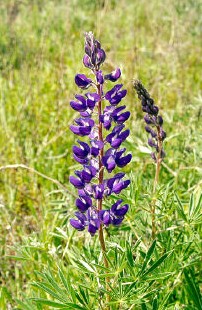Silky lupine facts for kids
Quick facts for kids Silky lupine |
|
|---|---|
 |
|
| Conservation status | |
| Scientific classification | |
| Genus: |
Lupinus
|
| Species: |
sericeus
|
Lupinus sericeus, often called silky lupine or Pursh's silky lupine, is a beautiful flowering plant. It is part of the legume family, which includes plants like peas and beans! You can find this plant growing wild across western North America. Its home stretches from British Columbia in Canada down to Arizona in the United States. It also grows east into Alberta and Colorado.
Contents
Silky Lupine: A Wildflower Friend
Silky lupine is a common and interesting plant. It's known for its pretty flowers and soft, hairy leaves. This plant plays a role in its natural environment. It provides food for some animals and helps keep the soil healthy.
What Does Silky Lupine Look Like?
This plant is a perennial herb. This means it lives for more than two years. It grows new stems each year from a strong, woody base and deep roots. The stems can grow up to 50 centimetres (20 inches) tall. They might branch out or grow straight up. These stems are covered in shiny, silvery, or reddish hairs.
The leaves of the silky lupine are also special. Each leaf has up to 9 smaller, lance-shaped leaflets. These leaflets can be up to 6 centimetres (2.4 inches) long. They are also covered in soft, silky hairs, which gives the plant its name!
Flowers and Seeds
The flowers of the silky lupine grow in a tall cluster called a raceme. There are many flowers in each cluster. They are usually purple or blue. Sometimes, you might see white or yellowish flowers too. The back of the top petal, called the banner petal, is often hairy.
After the flowers bloom, the plant produces fruit. This fruit is a hairy legume pod. It can be up to 3 centimetres (1.2 in) long. Inside each pod, there can be up to 7 seeds.
Where Does Silky Lupine Grow?
Silky lupine is a tough plant that can live in many different places. You can find it in forests, woodlands, and chaparral areas. It also grows in shrubsteppes, sagebrush fields, and grasslands.
This plant often prefers dry, rocky slopes. It grows best in open areas where it gets lots of sunlight. It can be found at both low and high elevations. Some silky lupines grow as high as 3,000 metres (9,800 ft) or even more! It's also common to see this plant in places that have recently had a wildfire.
Animals and Silky Lupine
Like many other lupines, silky lupine can be harmful to some animals if they eat too much of it. It is especially toxic to sheep. It can make them very sick. However, it is less harmful to cattle and horses. The plant contains natural chemicals called alkaloids that can cause problems.
Interestingly, silky lupine does not seem to harm wild animals. For example, white-tailed deer often eat this plant without any issues. Bighorn sheep in Montana also feed on it. Columbia ground squirrels enjoy eating the leaves and flowers. Many other small mammals and birds also eat different parts of the silky lupine.


